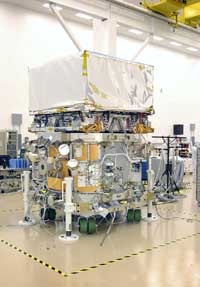
Handy Links
SLAC News Center
SLAC Today
- Subscribe
- Archives: Feb 2006-May 20, 2011
- Archives: May 23, 2011 and later
- Submit Feedback or Story Ideas
- About SLAC Today
SLAC News
Lab News
- Interactions
- Lightsources.org
- ILC NewsLine
- Int'l Science Grid This Week
- Fermilab Today
- Berkeley Lab News
- @brookhaven TODAY
- DOE Pulse
- CERN Courier
- DESY inForm
- US / LHC
SLAC Links
- Emergency
- Safety
- Policy Repository
- Site Entry Form

- Site Maps
- M & O Review
- Computing Status & Calendar
- SLAC Colloquium
- SLACspeak
- SLACspace
- SLAC Logo
- Café Menu
- Flea Market
- Web E-mail
- Marguerite Shuttle
- Discount Commuter Passes
-
Award Reporting Form
- SPIRES
- SciDoc
- Activity Groups
- Library
Stanford
Around the Bay
LAT Instrument Integrated with Spacecraft
 On December 8, a crane lifted the
Large Area Telescope (LAT) onto the Gamma-ray Large Area Space Telescope (GLAST) spacecraft,
bringing the instrument a few meters and a giant leap closer to space.
On December 8, a crane lifted the
Large Area Telescope (LAT) onto the Gamma-ray Large Area Space Telescope (GLAST) spacecraft,
bringing the instrument a few meters and a giant leap closer to space.
In a clean room in Gilbert, Arizona, 15 people from SLAC and the aerospace company that built the spacecraft—General Dynamics Advanced Information Systems—carefully guided the LAT into place and mechanically attached it to the spacecraft. The instrument weighs about 7,000 pounds, while the spacecraft is a diminutive 2,000 pounds. Packed into a Delta 2 rocket, the ensemble will be launched into space later this year.
"The integration of the LAT instrument onto the spacecraft is a major milestone for the GLAST program. The instrument performance has met or exceeded all expectations," said LAT Project Manager Ken Fouts.
The instrument and spacecraft are now undergoing "full functional" tests, to make certain that everything responds correctly. GLAST program personnel from SLAC and the Naval Research Laboratory continue to work owl shifts in Arizona, running tests and checking the data the LAT generates when cosmic muons flow through it.
"We're trying to maximize the instrument run time here on Earth while we still have an opportunity to fix any problems we might find," said Fouts. "Once we’re on orbit, we can still upload software patches if we need to, but the hardware is out of reach and must perform as designed."
Once the integration is complete in late February, the entire GLAST observatory (the spacecraft, the LAT, and an instrument called the Gamma Ray Burst Monitor) will go through environmental "shake and bake" testing to ensure it's prepared for the rigors of launch and space.
The launch from Cape Canaveral is slated for this fall. Let the countdown begin!
—Heather Rock Woods, January 11, 2007
Above image: The LAT instrument (covered for dust protection), has been mechanically attached to the GLAST spacecraft below, which sits on wheels to be moved to different testing stations.